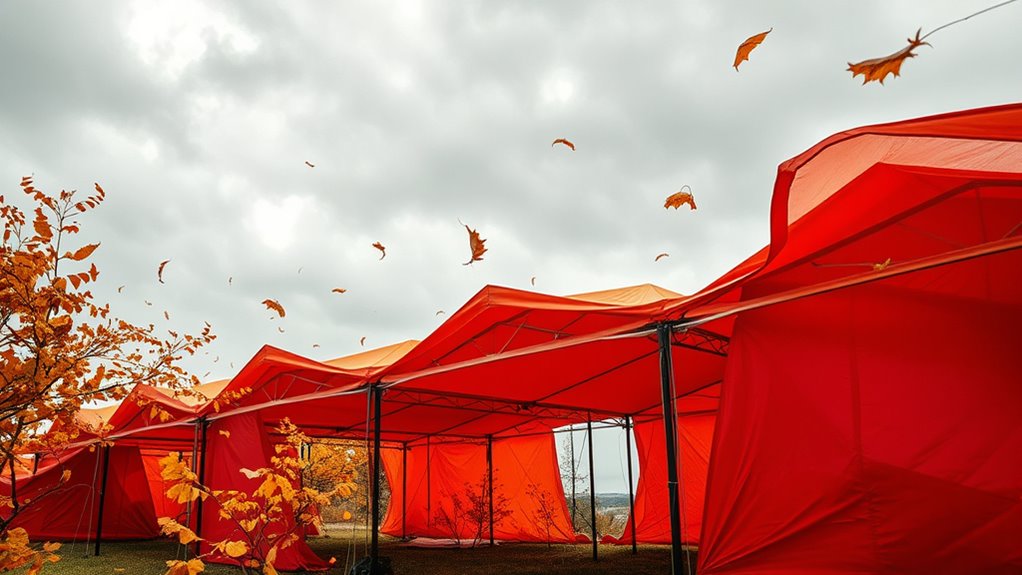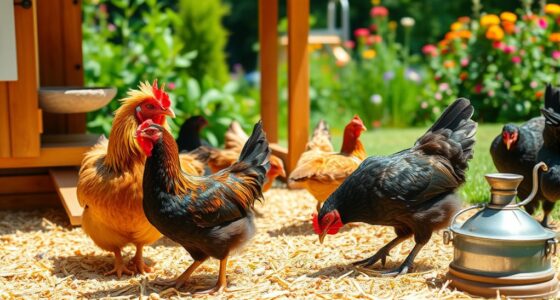To choose a portable shelter for autumn windstorms, focus on durable fabrics like ripstop nylon or reinforced polyester with weatherproof coatings and high wind resistance ratings. Look for models that are easy to assemble, lightweight, and have strong anchoring systems to stay stable during gusts. Consider the shelter size for your needs and make sure it has good ventilation. Staying informed on expert advice and user feedback will help you select the best option—more tips follow to guide your choice.
Key Takeaways
- Select shelters with high wind resistance ratings and certified standards like ASTM or ANSI for reliable storm durability.
- Choose lightweight, easy-to-assemble models with reinforced anchoring systems for quick deployment in emergencies.
- Opt for durable, weatherproof fabrics with UV protection and reinforced seams to withstand wind, rain, and debris.
- Consider shelter size and design to ensure stability and sufficient space while maintaining portability.
- Review user feedback for real-world performance in high winds and prioritize features like reinforced framing and stability accessories.
Assessing Durability and Material Quality
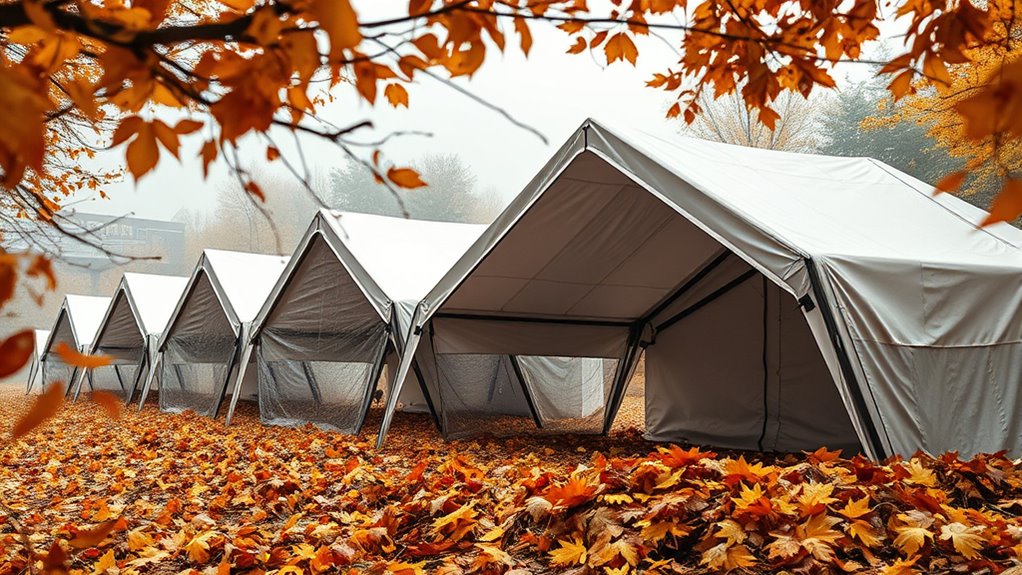
When choosing a portable shelter for autumn windstorms, evaluating durability and material quality is essential. You want a shelter that can withstand strong gusts and harsh weather conditions, so check the fabric’s strength and resistance ratings. Look for high-quality materials like ripstop nylon or reinforced polyester, which offer durability without adding excessive weight. Additionally, consider fabric color options; lighter colors may reflect sunlight, while darker shades can hide dirt better. Don’t forget to appraise aesthetic design features that appeal to your style—sleek lines, modern finishes, and customizable options can make your shelter both functional and visually appealing. Prioritizing these factors ensures your shelter provides reliable protection while still fitting your aesthetic preferences.
Understanding Wind Resistance Ratings

Understanding wind resistance ratings helps you choose shelters that can withstand autumn storms. You’ll want to look at different wind rating systems, material durability factors, and certification standards. These points guarantee you pick a shelter that keeps you safe when the wind picks up. Additionally, knowing about penetration testing can help assess how well a shelter can resist external force impacts during storms. Exploring celebrity transformations and their resilience offers insights into overcoming adverse conditions, which can be metaphorically applied to understanding shelter durability. Recognizing the importance of contrast ratio in evaluating the strength of shelter materials can further aid your decision-making process. Incorporating AI-powered testing methods can provide more precise insights into a shelter’s wind resistance capabilities, ensuring safer choices. Moreover, understanding material composition and its influence on wind resistance can lead to better shelter selections.
Wind Rating Systems
Wind resistance ratings are essential for selecting a portable shelter that can withstand autumn windstorms, as they indicate how well a structure can endure high winds. These ratings help you understand a shelter’s capacity to resist wind load and prevent damage from storm surge effects. To evaluate a shelter’s wind rating system, consider these key points:
- Look for shelters rated for the highest wind speeds in your area, especially if storm surge is a concern.
- Check the certification standards, such as those from ASTM or ANSI, which verify the shelter’s wind resistance.
- Understand the rating scale—higher ratings mean better wind resistance, ensuring your shelter can withstand strong gusts during windstorms.
- Incorporating protective styling benefits into your shelter choice can also enhance its durability against wind damage. Additionally, understanding the industry standards for wind resistance helps you make informed decisions and select a shelter that offers optimal protection. Being aware of wind rating systems ensures you choose a structure that provides maximum safety and durability during seasonal storms. Familiarity with building code requirements can further assist in selecting compliant and resilient shelters. Knowing how testing procedures are conducted provides additional confidence in the reliability of the wind resistance ratings.
Material Durability Factors
Material durability plays a crucial role in a shelter’s ability to resist wind damage, as the quality of the materials determines how well it can withstand high gusts and storm conditions. Key factors include fabric breathability, which prevents mold and deterioration, and color fade resistance, maintaining appearance after exposure. Strong, durable fabrics reduce tearing and can endure repeated wind stress. Consider the following table:
| Factor | Importance |
|---|---|
| Fabric Breathability | Prevents mold, extends lifespan |
| Color Fade Resistance | Maintains shelter appearance over time |
| Material Strength | Ensures resistance to tearing and high winds |
Choosing materials with high durability ratings guarantees better wind resistance and longer shelter lifespan. Additionally, selecting fabrics with UV protection can further enhance the durability against sun exposure and weathering. Incorporating reinforced seams can also improve the overall strength and resilience of the shelter during severe storms. Furthermore, using weather-resistant coatings can provide an extra layer of protection against rain and wind infiltration, extending the shelter’s useful life. Regular inspection and maintenance of the fabric integrity are essential to identify potential weaknesses before storm events occur. To maximize their effectiveness, selecting wind-resistant materials designed specifically for storm-prone conditions can significantly improve shelter resilience.
Certification Standards
Certification standards provide essential benchmarks for evaluating a shelter’s wind resistance capabilities, ensuring that products meet safety and performance requirements. These standards help you select shelters that withstand autumn windstorms while maintaining fire safety and aesthetic appeal. When reviewing certifications, consider:
- The wind resistance rating, indicating how well the shelter can handle strong gusts. Research supports 16PF for predicting job performance, which can guide the selection of durable materials suited for harsh conditions. Additionally, understanding regional wind resistance ratings can help determine the most suitable shelters for specific areas prone to storms. Recognizing the importance of personality assessment can also aid in choosing designs that best fit your personal or community needs. Incorporating material strength testing can further ensure that the shelter’s construction can endure extreme weather events.
- Fire safety certifications, ensuring the shelter’s materials meet safety regulations.
- Design standards that preserve aesthetic appeal without compromising durability.
- Incorporating organization-approved testing procedures can further validate a shelter’s ability to withstand harsh weather conditions effectively.
Considerations for Ease of Setup and Portability
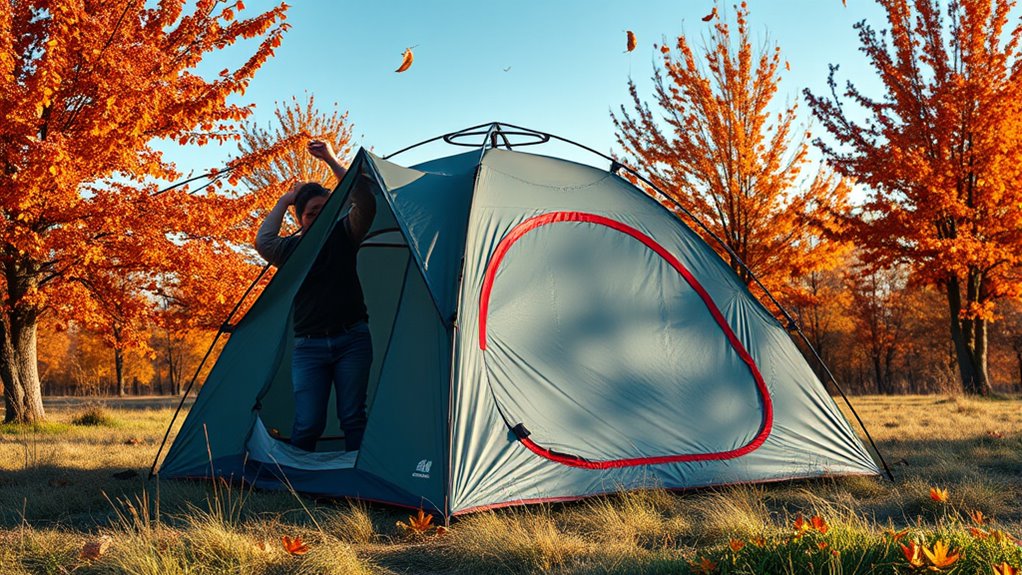
When choosing a portable shelter, consider how easy it is to set up and move. Lightweight construction materials make transportation simpler, saving you time and effort. Look for models with straightforward assembly processes to guarantee quick, hassle-free setup when you need it most. Additionally, selecting a shelter with easy-to-follow instructions can further streamline the setup process and ensure a smooth experience during windy autumn conditions. Ensuring the shelter’s compliance with safety standards adds an extra layer of protection and peace of mind during storms. Being aware of dog behavior and companionship can help you select a shelter that accommodates your pets comfortably and safely during adverse weather.
Lightweight Construction Materials
Choosing lightweight construction materials can substantially simplify the setup and transportation of portable shelters during autumn windstorms. To achieve this, focus on materials that balance durability with ease of handling. First, opt for storm resistant fabrics that are lightweight yet strong enough to withstand high winds and rain. Second, select lightweight framing options, like aluminum or reinforced composites, that make assembly easier without sacrificing stability. Third, consider modular components that can be quickly assembled and disassembled, reducing setup time and effort. These choices ensure your shelter remains portable and resilient, even in challenging weather. Prioritizing lightweight construction materials helps you deploy your shelter swiftly and securely, providing reliable protection during autumn windstorms.
Simple Assembly Processes
To guarantee your portable shelter is quick and easy to set up during autumn windstorms, prioritize simple assembly processes. A well-designed portable shelter features a straightforward portable design that minimizes the time and effort needed for assembly. Look for models with clear, step-by-step assembly instructions, preferably with visual aids or labeled parts. Avoid shelters requiring complicated tools or numerous steps, as these can slow you down in critical moments. A shelter with a user-friendly design allows you to quickly establish a secure protective space without frustration. Ensuring the assembly process is simple not only saves time but also enhances safety during unexpected storms. Choose a shelter that emphasizes ease of setup, so you can focus on securing your safety and comfort.
Analyzing Anchoring Systems and Stability Features
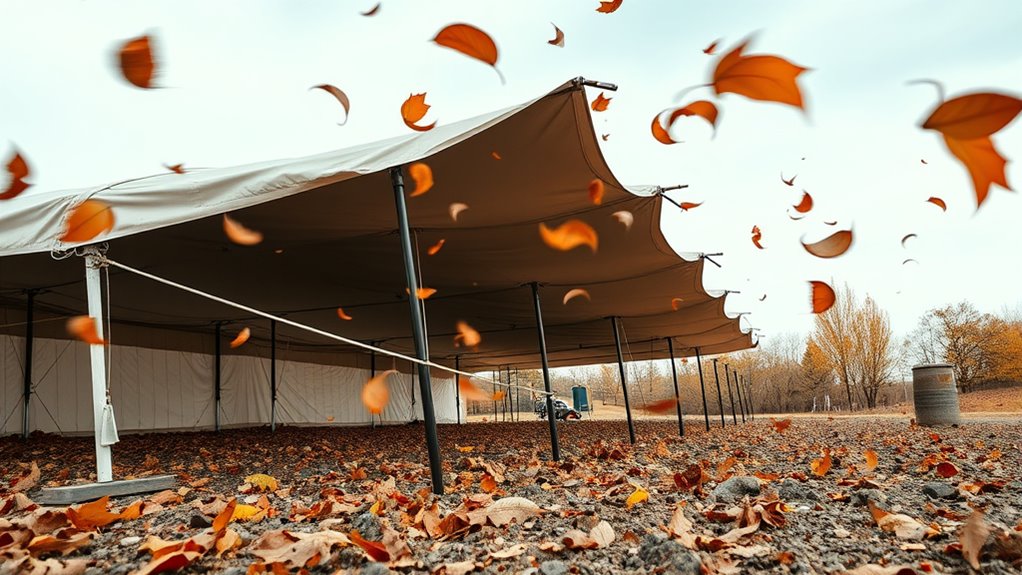
Effective anchoring systems are crucial for ensuring your portable shelter stays put during autumn windstorms. To evaluate anchoring mechanisms and stability features, consider these key points:
- Check if the shelter includes heavy-duty stakes, guy lines, or weights to secure it against strong gusts.
- Look for integrated stability features like reinforced corners or wind-resistant frames that enhance durability.
- Ensure the anchoring system is easy to set up and adjust, providing reliable hold without complicated steps.
A well-designed anchoring system combines sturdy anchoring mechanisms with stability features that prevent shifting or collapse. These elements work together to keep your shelter stable in turbulent conditions, giving you peace of mind during stormy autumn weather. Always prioritize these factors when selecting a portable shelter.
Evaluating Size and Space for Your Needs
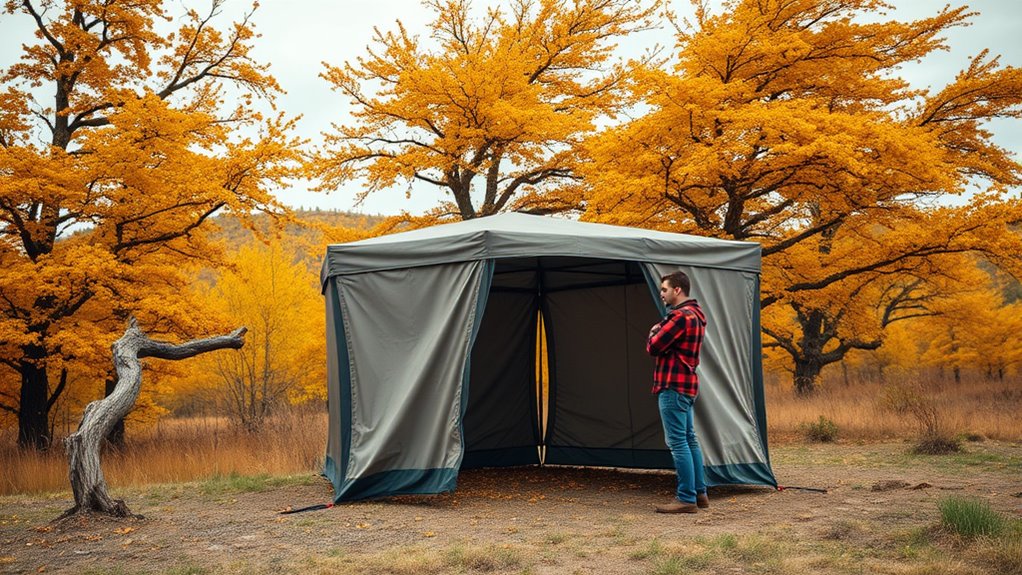
Evaluating the size and space of your portable shelter is essential to guarantee it meets your needs during autumn windstorms. Consider how many people or items you’ll need to accommodate comfortably, and choose a shelter that offers enough room without excess bulk. Pay attention to fabric choices, as sturdier materials add to the shelter’s stability and longevity. The fabric’s thickness and weave can influence how well it withstands wind and debris. Additionally, color options matter—lighter shades may reflect sunlight and keep the interior cooler, while darker colors could absorb heat. Make sure the shelter’s dimensions suit your setup location and storage capacity. Proper sizing assures you stay protected and comfortable without sacrificing portability or ease of assembly.
Weatherproofing and Waterproof Capabilities
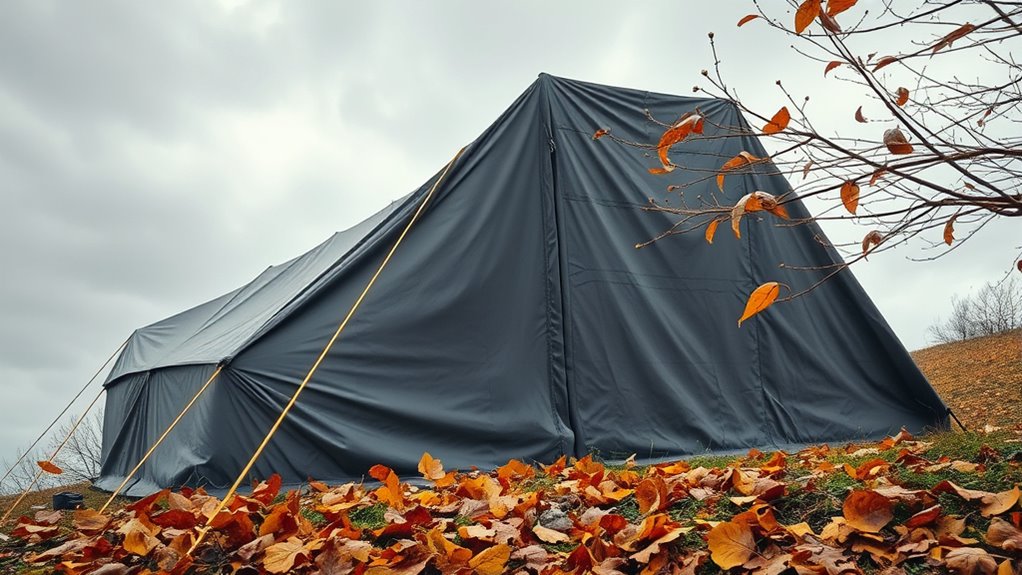
When choosing a portable shelter for autumn windstorms, guaranteeing it has reliable weatherproofing and waterproof capabilities is essential. You want protection against rain, wind, and debris, so consider these key features:
- Use high-quality, sealed seams and waterproof fabrics to prevent leaks.
- Look for shelters with integrated solar options that enhance energy efficiency without compromising waterproofing.
- Prioritize designs that balance durability with aesthetic appeal, so your shelter looks good while staying protected.
Good weatherproofing also helps maintain a comfortable interior environment and supports solar integration for off-grid power. A well-designed, waterproof shelter ensures safety and comfort during stormy weather, making it a smart investment for unpredictable autumn winds.
Ventilation and Climate Control Features
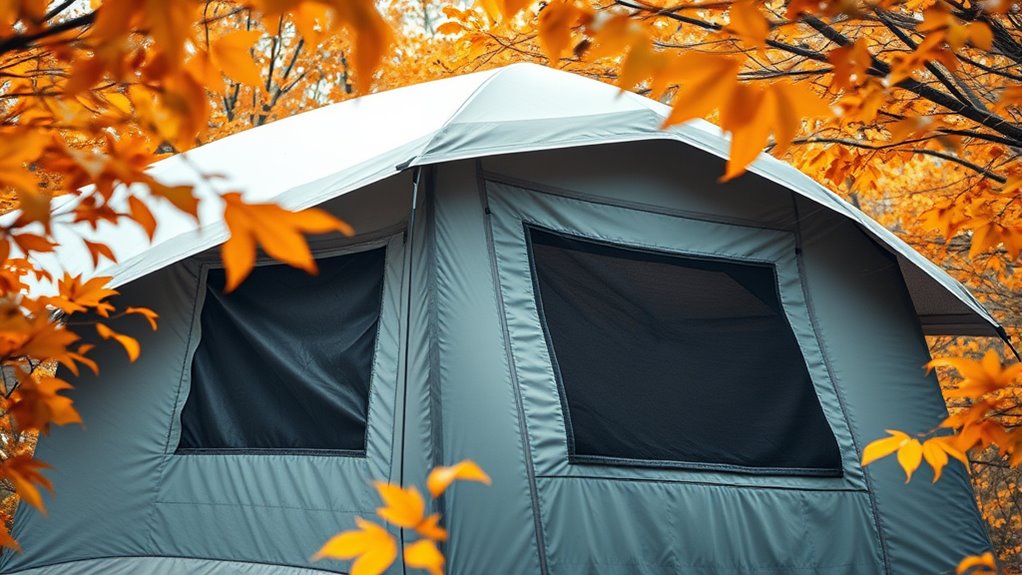
During autumn windstorms, proper ventilation and climate control are essential to maintaining a comfortable and safe shelter environment. Good ventilation systems prevent condensation buildup, reduce indoor humidity, and ensure fresh air circulation, which helps prevent mold and odors. Look for shelters with adjustable vents or screened windows to control airflow based on weather conditions. Climate control features, such as built-in heaters or thermal insulation, keep the interior warm during chilly nights. Some shelters incorporate passive ventilation designs that use natural airflow to regulate temperature. Prioritizing these features guarantees you stay comfortable and protected from the elements, reducing the risk of health issues caused by poor air quality or temperature fluctuations. Effective ventilation and climate control are vital for a shelter’s safety and livability during autumn windstorms.
Budget-Friendly Options Without Compromising Quality
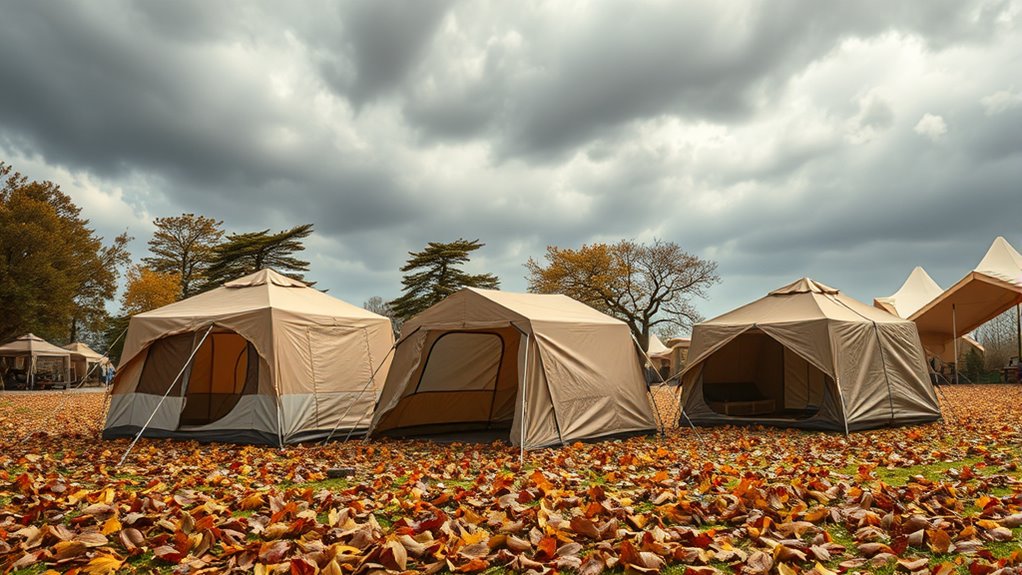
Finding a budget-friendly shelter that still offers reliable protection during autumn windstorms is entirely possible if you know where to look. Start by focusing on portable tents made with durable shelter fabrics, which provide solid resistance against wind and rain without breaking the bank. To get the best value, consider these tips:
- Look for tents with reinforced seams and quality shelter fabrics that withstand harsh conditions.
- Opt for lightweight, compact designs that are easy to set up and transport.
- Compare prices and reviews to find options that balance affordability and durability.
User Reviews and Expert Recommendations
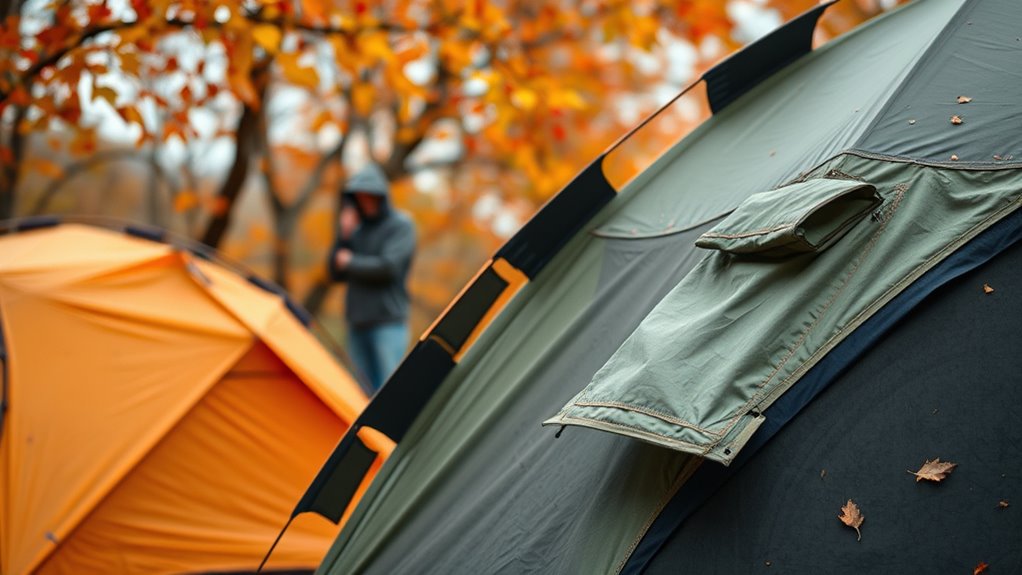
User reviews and expert recommendations can give you valuable insights into a shelter’s durability and material quality. By paying attention to these opinions, you can identify options that hold up well against strong autumn winds. Trusting experienced advice helps you choose shelters that truly stand the test of time.
Durability and Material Quality
When selecting a portable shelter for autumn windstorms, prioritizing durability and material quality is essential. You want a tent that withstands strong gusts and harsh weather conditions. To guarantee this, consider these factors:
- Check the fabric’s quality—look for waterproof, UV-resistant materials that resist tearing.
- Evaluate tent ventilation—adequate airflow reduces condensation and maintains comfort during storms.
- Review fabric color options—darker colors can absorb heat but may fade faster, while brighter shades reflect sunlight and stay vibrant longer.
User reviews highlight tents with sturdy frames and high-quality fabrics lasting through multiple storms. Experts recommend choosing models with reinforced seams and durable fabric coatings. These features boost longevity and weather resistance, ensuring your shelter remains dependable during autumn windstorms.
Expert-Backed Recommendations
Expert reviews and user feedback are invaluable when choosing a portable shelter for autumn windstorms, as they provide real-world insights into how tents perform under tough conditions. Experts often highlight solar efficiency as essential, ensuring your shelter can harness sunlight for power during extended stays. They also emphasize aesthetic appeal, so your shelter blends functionality with visual appeal. User reviews reveal which tents maintain stability and offer ideal solar efficiency even in high winds, helping you avoid models that falter in stormy weather. Trusted recommendations guide you toward shelters with smart design features that enhance both performance and appearance. By paying attention to expert advice and real user experiences, you can select a portable shelter that balances durability, energy efficiency, and style, making it a reliable choice for autumn windstorms.
Maintenance and Care for Longevity
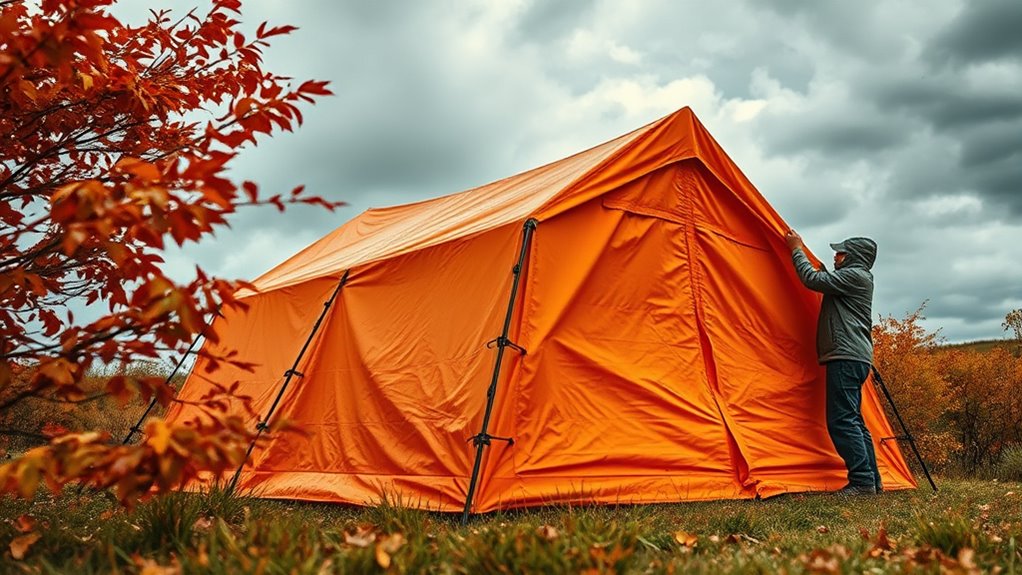
Regular maintenance is key to guaranteeing your portable shelter withstands autumn windstorms over time. To keep it durable and visually appealing, focus on these three steps:
Consistent upkeep ensures your portable shelter endures autumn storms while remaining attractive.
- Inspect and secure seasonal lighting to prevent damage from gusts and avoid unnecessary wear.
- Clean the shelter’s surface regularly, removing dirt and debris that could compromise its aesthetic design.
- Check seams, zippers, and anchors to ensure stability, making repairs as needed to maintain structural integrity.
Frequently Asked Questions
What Safety Features Should I Prioritize in a Portable Shelter?
When selecting a portable shelter, you should prioritize safety features like storm resistant materials and secure anchoring. Storm resistant materials guarantee the shelter can withstand high winds and debris, keeping you safe. Secure anchoring prevents the shelter from shifting or collapsing during strong gusts. Look for shelters with reinforced frames, heavy-duty fabric, and reliable anchoring systems. These features help you stay protected and stable during challenging weather conditions.
How Do I Choose the Best Shelter for Extreme Wind Conditions?
Imagine facing a fierce windstorm and your shelter holds firm—that’s what choosing the right one is about. Focus on storm resistance features like reinforced frames and wind-resistant designs. Prioritize material durability, selecting tough fabrics like ripstop nylon or PVC-coated polyester that can withstand high winds. Check for anchoring options and aerodynamic shapes to minimize wind impact. With these choices, you’ll guarantee your shelter stands strong when nature’s fury strikes.
Are There Eco-Friendly Options for Portable Autumn Shelters?
You’re wondering if eco-friendly options exist for portable autumn shelters. Yes, you can find shelters made from sustainable materials that reduce environmental impact. Look for biodegradable options that break down naturally after use, helping protect the environment. These shelters are not only eco-conscious but also practical, providing reliable protection during windstorms while supporting sustainability efforts. By choosing biodegradable and sustainable materials, you make a positive difference for the planet.
How Does Shelter Weight Affect Transport and Setup Ease?
Think of shelter weight as the heartbeat of your setup journey. Heavier shelters anchor you, making transportation feel like moving a mountain, and setup a formidable climb. Lighter shelters, on the other hand, dance with portability, turning setup into a simple, breezy task. For effortless shelter portability and setup simplicity during autumn windstorms, opt for lightweight options that let you move swiftly and set up with ease.
Can I Customize Portable Shelters for Additional Protection?
Yes, you can customize portable shelters for extra protection. Look for options that allow you to select shelter materials with enhanced durability, such as heavy-duty fabrics or reinforced frames. Many manufacturers offer customization options like adding extra vents, sealing seams, or installing protective covers. These modifications help increase resistance against wind, rain, and debris, ensuring your shelter provides better protection during storms. Always check with the supplier to see what customization options are available.
Conclusion
So, as you pick your perfect autumn shelter, remember that even the sturdiest tent can’t outsmart a stubborn wind. Sometimes, investing in quality means trusting reviews over price tags, and setting up correctly beats endless options. But don’t get too comfortable—nature’s surprises can still surprise you. After all, no shelter is foolproof, so enjoy the breeze while it lasts, because next storm, you might just wish you’d chosen differently.

